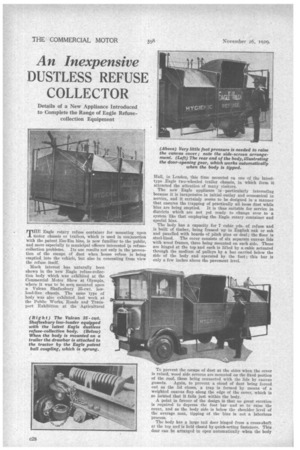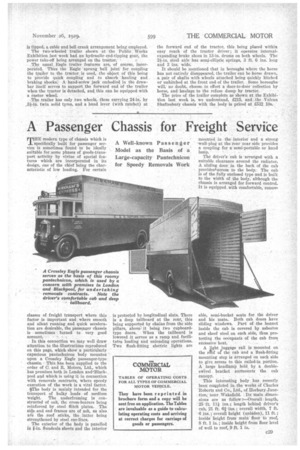An Inexpensive DUSTLESS REFUSE COLLECTOR
Page 66

Page 67

If you've noticed an error in this article please click here to report it so we can fix it.
Details of a New Appliance Introduced to Complete the Range of Eagle Refusecollection Equipment TEE Eagle rotary refuse container for mounting upon motor chassis or trailers, which is used in conjunction with the patent Ess-Ern bins, is now familiar to the public, and more especially to municipal officers interested in refusecollection problems. Its use results not only in the prevention of the escape of dust when house refuse is being emptied_ into the vehicle, but also in concealing from view the refuse itself.
Much interest has naturally been shown in the new Eagle refuse-collection body which was exhibited at the Commercial Motor Show at Olympia, where it was to be seen mounted upon a Vulcan Shaftesbury 35-cwt. lowload-line chassis. The same type of body was also exhibited, last week at the Public Works, Roads and Transport Exhibition at the Agricultural Hall, in London, this time mounted on one of the latesttype Eagle two-wheeled trailer chassis, in which form it attracted the attention of many visitors.
The new Eagle appliance is particularly interesting because it is inexpensive in initial outlay and economical in service, and it certainly seems to be designed in a manner that ensures the trapping of practically all loose dust while bins are being emptied. It is thus suitable for service in districts which are not yet ready to change over to a system like that employing the Eagle rotary container and special bins.
The body has a capacity for 7 cubic yds. of refuse and is built of timber, being framed up in English oak or ash and panelled with boards of pitch pine or deal; the floor is steel-lined. The cover consists of six separate canvas lids with wood frames, three being mounted on each side. These are hinged at the top and each is lifted by a cable actuated through the medium of pulleys by a bar carried below the side of the body and operated by the foot; this bar is only a few inches above the pavement level.
To prevent the escape of dust at the sides when the cover is raised, wood side screens are mounted on the fixed portion of the roof, these being connected with the lids by canvas gussets. Again, to prevent a cloud of dust being forced out as the lid closes, a trap is formed by means of a weighted canvas flap along the edge of the cover, which is so located that it fails just within the body.
A point in favour of the design is that no great exertion is required to depress the foot bar and so to raise the cover, and as the body side is below the shoulder level of the average man, tipping of the bins is not a laborious process.
The body has a large tail door hinged from a cross-shaft at the top and is held closed by quick-acting fasteners. This door can be arranged to open automatically when the body
is tipped, a cable and bell crank arrangement being employed. The two-wheeled trailer shown at the Public. Works Exhibition last we.ek had an hydraulic. end-tipping gear, the Power take-off being arranged on the tractor. •
The usual Eagle trailer . featuresare, of course, incorporated. Thns the Eagle sprung •ball joint or coupling the trailer to the tractor isused, the object of this being to provide quick conplingand to absorb 'hauling and braking Shocks: A band screw jack embodied in the drawbar itself serve's to support the forward end of the trailer when the tractor is detached, and this can be equipped With
a castor wheel. .
-Thetrailer has only two wheels, these carrying 24-in, by twin Solid tyres, and, a hand lever (with ratchet) at the forward end of the tractor, this being placed within easy reach 0 the tractor driver ; it operates internalexpanding brake shoes in 13-in. drums on both wheels. The 2i-in. steel axle has semi-elliptic springs, 3 ft. 6 ins. long and 3 ins. wide.
• It should be mentioned that in boroughs where the horse has not entirely disappeared, the trailer can be horse drawn, a. pair of shafts with wheels attached being quickly hitched or unhitched at the front end of the trailer. Some boroughs will; no doubt, choose to effect a door-to-door collection by horse, and haulage to the refuse dump by tractor.
The price of the trailer complete as shown at the Exhibi• tion last week is, we understand, £215, and the Vulcan Shaftesbury chassis with the body is priced at £532 19s.




























































































































